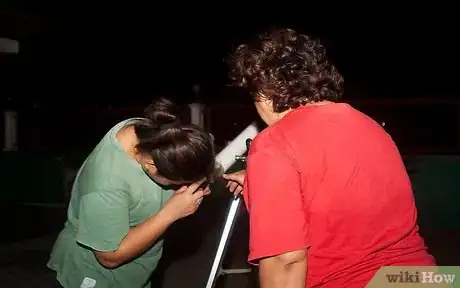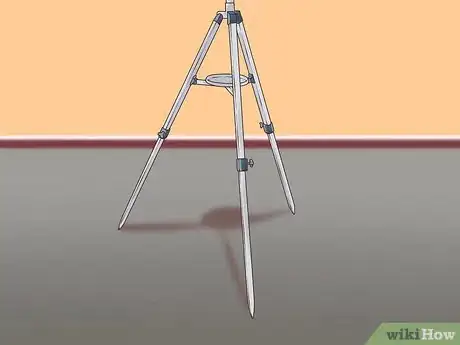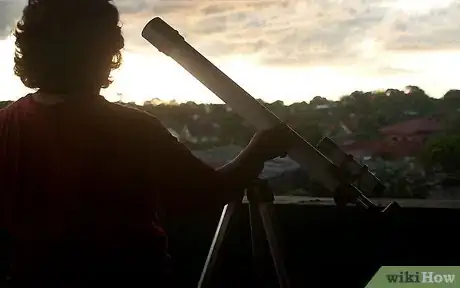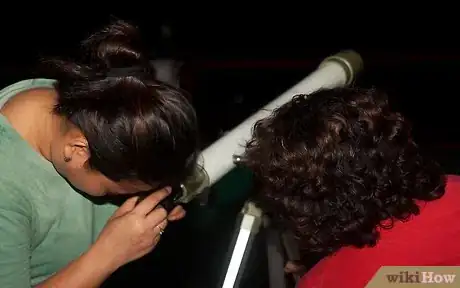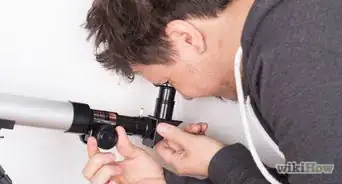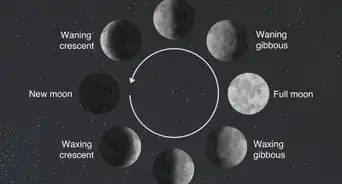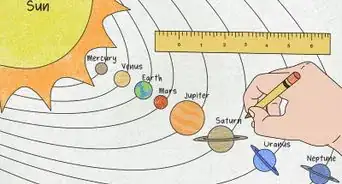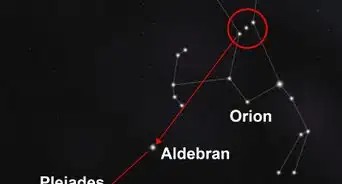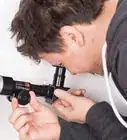wikiHow is a “wiki,” similar to Wikipedia, which means that many of our articles are co-written by multiple authors. To create this article, 37 people, some anonymous, worked to edit and improve it over time.
There are 8 references cited in this article, which can be found at the bottom of the page.
wikiHow marks an article as reader-approved once it receives enough positive feedback. In this case, 83% of readers who voted found the article helpful, earning it our reader-approved status.
This article has been viewed 343,330 times.
Learn more...
Telescopes gather light and make for the most spectacular viewing experiences. The thrill of viewing distant galaxies, brilliant star clusters, unique nebulae, solar system planets and lunar features is nearly indescribable.
Steps
Getting a Telescope
-
1Consider the type of telescope. Different telescopes are better for different types of viewing. There are really on three basic telescope types: refractor, reflector and catadioptric. Which one you choose will be based on what you want to observe, where you are, and so on.[1]
- The refractor basically has a long thin tube with an objective lens at the front that collects and focuses the light. This one is better for viewing the Moon and planets, usually giving a nice, crisp image. It travels well and doesn't need much maintenance. Unfortunately, it is very hard to see faint objects like galaxies and nebulae.
- The reflector employs a large concave mirror rather than a lens for the purposes of accumulating and focusing light. This is one of the better beginner telescopes and it usually has pretty good visibility, although water has a tendency to condense on the optics of the telescope which can be irritating. Also, you can't view terrestrial objects with this telescope, because they will appear upside-down.
- The catadioptric is a compound telescope, combining both lenses and mirrors. They are good photographic telescopes and they are a lot easier to carry than the reflector. This one tends to be more versatile, but they do tend to be more expensive than the other types.
-
2Consider where you live. You'll need different power levels considering where you are. If you have an area where the light pollution is better or worse. If you are in an area where it rains more, etc.[2]
- If you want to bird watch (for example) with your telescope, you'll be better off not choosing the reflector telescope because it won't show you terrestrial objects.
- If you're in a place where it dews frequently and you're planning on using your telescope at night, you'll need to consider whether choosing a refractor or catadioptric telescope might be your best option.
Advertisement -
3Consider what you want to look at. Objects like the planets, the Moon, and closer stars need a high power, good contrast and sharp resolution in a telescope. So if this is what you want to look at, your best bet is to go with a refractor or a reflector. If you're looking at faint objects such as galaxies and nebulae, you'll need a bigger aperture and choose a big reflector telescope.
-
4Consider the power capabilities of your telescope. People generally have the mistaken impression that more power automatically means higher resolution and better viewing, but this is not actually true. High power simply dilutes the brightness of the image and amplifies any blurriness.[3]
- For any telescope the maximum amount of magnification equals 50-power per inch of aperture. So say you have a 6-inch reflector. 300-power is as high as you should go (for a 3-inch reflector it would be about 150-power).
- Even if you're using a Barlow lens, magnifying it too far will only result in a blurred image. The telescope's image can only be blown up to a certain point.
Understanding Your Telescope
-
1Learn the finderscope. This is typically attached the side of the telescope. It displays more of the sky than the scope itself. For instance, a 50 power telescope covers an area about as small as the fingernail on your little finger, whereas an 8x finderscope covers an area about the size of a golf ball.[4]
-
2Learn the mount. Telescopes typically come in two types: equatorial or altazimuth. You'll need to know which kind of telescope you have so you can learn how to operate your telescope.[5]
- Altazimuth mount operates my going up and down and side to side, making it easier for beginners to operate. It is more simple than the equatorial telescope.
- Equatorial mount swings across the celestial North to South and East to West. The polar axis (which is the rotating part closer to the telescope's base) needs to be aligned to Polaris, the North Star. It will then follow the motion of the sky around this point, moving from east to the west (as the stars move).
- It takes more time to get accustomed to the equatorial mount each time you want to look at a different star or planet you have to unlock the axis and take aim at the heavenly body using the finderscope and lock it once you have the general location. From there you'll use the slow motion cable controls or panhandle controls to make the smaller movements. The equatorial mount is generally considered to be more helpful.
-
3Learn the tripod. You'll need to make sure that the three legs of your telescope are properly balanced otherwise the telescope can fall over and become damaged. When you're scouting out locations, always look for areas that have a flat, level area for your telescope.
Scanning the Sky
-
1Learn the sky. Before you start tromping around in the dark with your expensive telescope, you'll need to figure out what you're looking for. Maybe you want to have a gander at the moon, or want to check out the planets. Maybe you're interested in a meteor shower. You'll need to find out timing, place, weather, etc.[6]
- If you're trying to observe the stars, for instance, going out on a moon-lit night won't get you very far.
- Look at books on stars and constellations. These will tell you when the best viewing times are and when the planets are easiest to be seen.
- Examine sky charts so that when you are out in the dark you know where to point your telescope.
- Train your eye. To do so, make sketches of the moon and the planets. You don't have to be a great artist to capture them as accurately as possible. This will help you to look more closely at the sky and observe details.
-
2Choose your spot. You'll need to choose your spot carefully, once you've decided what you're looking for and where it will be. It will need to be accessible at night and have a place with solid level ground for your telescope's tripod.[7]
- You'll need to consider light pollution. For instance, if you're in a big city, going up on a high roof (As long as it is safe) can get you away from the worst of the light pollution and allow you to see more clearly.
- Try to avoid decks and blacktop driveways and concrete. Footsteps on a deck can cause vibrations in the image. Blacktops driveways and concrete can create thermal issues for your telescope.
-
3Practice. You'll need to practice setting up your telescope and pointing to the correct part of the sky before you start fiddling around at night. Otherwise it is very easy to lose bits of your telescope and forget how to do something.[8]
- For practice set up your telescope and, using the lowest power eyepiece, point the main scope at something about 100 feet (30.5 m) away like a tree (not the sun!). Center the object in your crosshairs and make sure it's clear. Switch to a higher powered eyepiece and try again.
-
4Be comfortable. Make sure that when you're having your big night out with the stars that you have dressed appropriately. If it is going to be cold, make sure you have the right clothes on and bring along a canister of something warm.
Community Q&A
-
QuestionDo you keep both eyes open, or do you close the eye that is not looking through the telescope?
 Community AnswerYou keep both eyes open because if you close one eye, your open eye vibrates slightly. This leads to the image being blurrier.
Community AnswerYou keep both eyes open because if you close one eye, your open eye vibrates slightly. This leads to the image being blurrier. -
QuestionIs the short lens the lowest power lens?
 Community AnswerNo. The shortest one is the most powerful. Don’t use too much power or it’ll be too blurry though.
Community AnswerNo. The shortest one is the most powerful. Don’t use too much power or it’ll be too blurry though. -
QuestionWhat do I do if the planet images are crystally, and I can't get a clear image showing features and colors?
 Community AnswerMake sure you aren't in a light polluted area first, but if that's not the case, be very careful in your focus adjustment. Normally a "crystally" look could either mean humidity / dew in the scope or lens or you're looking at a star instead.
Community AnswerMake sure you aren't in a light polluted area first, but if that's not the case, be very careful in your focus adjustment. Normally a "crystally" look could either mean humidity / dew in the scope or lens or you're looking at a star instead.
Warnings
- Never aim the telescope at the sun. Even if you have a sun filter, the dark glass can crack and destroy your sight.⧼thumbs_response⧽
Things You'll Need
- Star charts to help locate an item in the heavens
- The telescope and the necessary accessories
- Snacks and hot beverages to stave off the chill of cool nights
- Warm clothes (if it is cold)
References
- ↑ https://skyandtelescope.org/astronomy-equipment/how-to-choose-a-telescope/
- ↑ https://skyandtelescope.org/astronomy-equipment/types-of-telescopes/
- ↑ http://www.space.com/14485-skywatching-telescopes-beginners-guide.html
- ↑ https://www.skyatnightmagazine.com/advice/how-set-up-finderscope-on-telescope/
- ↑ https://www.skyatnightmagazine.com/advice/a-basic-guide-to-telescope-mounts/
- ↑ https://www.skyandtelescope.com/astronomy-resources/stargazing-basics/learn-the-sky/
- ↑ https://www.space.com/14485-skywatching-telescopes-beginners-guide.html
- ↑ https://www.skyatnightmagazine.com/advice/help-family-kids-use-telescope-astronomy/
About This Article
To use a telescope, first learn about the night sky and decide whether you want to look at the moon, a planet, or a constellation. That way you’ll know where to look when you set up your telescope! When you’re ready to do your viewing, find a spot that’s as far away from outside lights as possible so you’ll have the clearest view. Then, set your telescope up on level ground so it's balanced and stable. Finally, use a small finderscope if you’re looking at something in a limited area, like a planet, or a larger one to see something bigger, like a constellation. To learn how to choose the best telescope for where you live and what you want to see, read on!



